Review: Anker PowerCore II Slim 10000
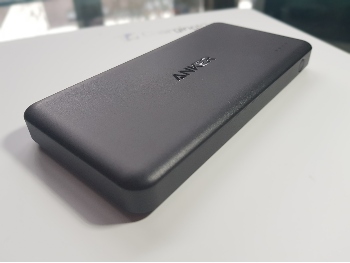
A small, durable, versatile and capacious power bank loaded with the features most power banks users are looking for. The Anker PowerCore II Slim 10000 has it all. It’s equipped with two USB ports (A and Micro), fast recharging, and a robust build that will easily satisfy most users. But a few tweaks could make this device even better. Read on to learn more.

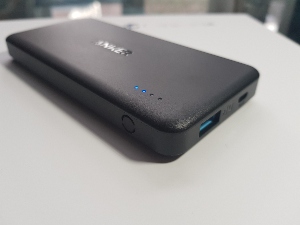
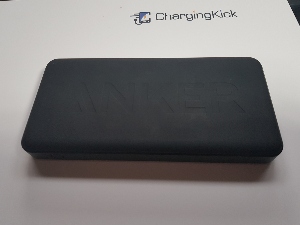
Pros & Cons:
Pros:
Great, minimalistic design
Phone-like dimensions and a rubber edge for secure and comfortable usage
High-quality material
Quick recharging (around 4 hours if you use a fast charger or 5 hours with a standard charger)
Charges most phones at least twice
Cons:
Only two USB ports
Inability to charge two devices simultaneously
Lack of USB-C
Slower than expected charging speed
Rating
Power & Performance (1 to 5 stars)
Design & Build (1 to 5 stars)
Technology (1 to 5 stars)
Overall Rating (average of above)
Key Specifications of a Product
Key Specs:
Capacity
10,000 mAh / 38.5 Wh
Dimensions (LxWxH)
5.4 x 2.6 x 0.6 in / 13.7 x 6.6 x 1.6 cm
Weight
7.4 oz / 210 gm
Output & Input Charging:
Average Charging Time of a Mobile Phone (average battery capacity 3000mAh)
1 hour and 25 minutes
Average Recharging Time (from 0% to 100%)
5 hours with standard charger or 4 hours with a fast charger
Ports
Micro USB Input: 5V/2A; 9V/2A
USB-A Output: 5-6V/3A; 6-9V/2A; 9-12V/1.5A
Charging Technology
Upgraded PowerIQ 2.0
Quick Charge 3.0
Fast charge for iPhone, Samsung Galaxy
Under 100WH
Safe to take on board.
Other Features
18-Month Limited Warranty
Lifetime Technical Support
Ideal For?
Travelers
Minimalists
Students
Adventurers
What Inside?
Anker PowerCore II Slim 10000
Protective pouch
USB-A to Micro USB cable
Manual in multiple languages
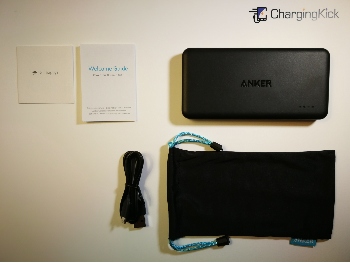
Power & Performance
Battery Capacity
Battery capacity in mAh, and Watts
The Anker PowerCore II Slim 10000 has a battery capacity of 10,000 mAh / 38.5 Wh. It’s a medium-capacity power bank that offers a great compromise between charging ability and small size & weight.
Capacity test - discharge the fully charged power bank
Have you ever wondered if the advertised power bank has the claimed battery capacity? Does it really have 5,000 mAh or 10,000 mAh as advertised? It’s possible to check it.
To check the actual battery capacity we need:
The fully charged power bank
A USB tester that shows the current, voltage, mAh, and charging time.
The USB mini adjustable load receives energy from the power bank and releases it safely via the fan. This is the safe way to discharge a fully charged power bank and measure the real battery capacity.
I connect the adjustable load (amperes are set on 2) to the USB tester and then plug it into the fully charged power bank. Once it’s done, now wait until the power bank’s battery goes flat. The screen on the USB tester will display the Watt-hours and the amount of mAh consumed. These data show the real battery capacity.
Let’s dive deep into the test and result. Following the aforementioned procedure, I tested Anker PowerCore II Slim 10000. Here are the results:
Capacity Test

Results
The key metrics from the test are:
Discharging Time - 3 hrs and 18 mins to discharge fully charged power bank
Watt-Hours - it’s 32.5 Wh
Ampere hour - 6,528 mAh was discharged from the power bank.
The real battery capacity is over 6,500 mAh. This amount of mAh precisely shows the energy that you can use to charge your mobile phone. If you are surprised why it’s not 10,000 mAh, that’s due to converting energy from 3.7V (power bank’s battery voltage) to 5V (USB’s voltage). This natural process occurs in every power bank.
Knowing advertised and the actual battery capacity it’s possible to measure the battery efficiency which is 88%. Manufacturers frequently don’t share this information. Efficiency above 90% is considered a very good one. Anker PowerCore II Slim with 88% battery efficiency can be considered a good one.
Disclaimer: Every test may vary, but only with a small variation.
How many times to charge the most sold mobile phones in 2020?
To put the battery capacity into perspective, I will use a formula for Real Battery Capacity and calculate how many times Anker PowerCore II Slim 10000 can charge the top 10 most popular mobile phones in 2020. Perhaps you own one of the enlisted phones or at least you know your mobile phone’s battery capacity.
From the previous test, we know the real battery capacity which is 88%.
Once you know the real battery capacity, simply divide it by the enlisted mobile phones’ battery capacity to find out how many times it can be charged.
Mobile Phone Model | How Many Times Can It Be Charged? |
4.61 | |
3.05 | |
2.88 | |
2.88 | |
3.24 | |
7.13 | |
2.88 | |
4.13 | |
3.09 | |
2.60 |
The Anker PowerCore II Slim 10000 will definitely charge all devices fully about one and half times, apart from the Moto G8, which has one of the biggest smartphone batteries. Phones with batteries around 3,000 mAh or less will charge fully at least twice. You can add an extra half-charge for most phones since we don’t usually wait for phones to die completely or charge them to 100%. This leaves extra power for later use.
The battery is sufficient for one day of heavy usage or two days of normal usage.
Output Charging
Charging Time & Power Usage
The main purpose of power banks is charging your devices, hence this review cannot be done without testing output charging. The knowledge of the charging time of devices is crucial. Frequently is one of the most important factors while purchasing a power bank.
For these tests, I used two mobile phones:
Huawei P10 with a battery of 3200 mAh (Huawei SuperCharge)
Samsung S8 with a battery of 3000mAh (Adaptive Fast Charging)
Both phones support fast-charging technology.
To record data (current, voltage, mAh, time) I used a USB tester.
Real-life examples, testing charging phones demonstrate what you can expect after purchasing the power bank.
The Anker PowerCore II Slim is equipped with Upgraded PowerIQ 2.0 and Quick Charge 3.0. I would expect charging to be faster than standard charging at 5V/2A. However, without USB-C, this could be a challenge. I tested it on a Huawei P10 and Samsung S8, both equipped with fast-charging technology. Here are the results.
Charging via USB-A (Huawei)
%20-%20Finish.jpg?alt=media&token=91c4a4df-8c2b-44ec-add1-9729e6a02682)
Standard charging at 5V/1.8A took nearly 90 minutes to charge the Huawei P10 (3,200mAh). The power bank delivered over 2,223 mAh of energy (11.35 Wh).
Charging via USB-A (Samsung)
%20-%20Finish.jpg?alt=media&token=2e741920-5628-4f46-a1aa-c34b3953e188)
This result can be misleading, as it shows that only 1264 mAh was discharged from the power bank, which is almost 1,000 mAh less than in Huawei’s test. It doesn’t mean that Samsung can be fully charged without using more energy. The truth is, the tested mobile phone worked on a higher voltage and lower amperage (on average 9V/1.3A) due to fast charging. The Watt-Hours (Wh) in this test were 11.4, while Huawei had 11.35, or nearly the same. In general, Watt-Hours is a better indication of battery power than amperage. Once we consider this and use these numbers in this formula: (Wh)*1000/(V) = (mAh), then we see that Samsung used 2,280 mAh of energy. The phone needed 1 hour and 25 minutes to fully charge. It’s a good result, but it was fast charging, so I expected about 70-80 minutes.
Round-up of output charging
A good overall result sufficient for most users. However, I expected a faster charging time in the range of 70-80 minutes.
Input Charging
The manufacturer claims the power bank can be recharged within 5 hours and 40 minutes with a 5V/2A charger and 4 hours via a Quick Charge charger. To discover whether these estimates are accurate, I charged the power bank twice. The first test, via a standard charger rated at 5V/2A charging speed; a charger most of us have. For the second charge, I used the charger rated 65W, the fastest type of charger, able to charge compatible laptops.
Recharging via Standard Charger 5V/2A
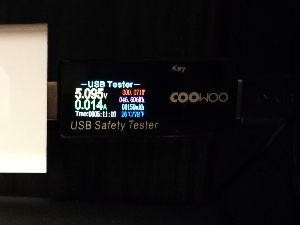
The Anker PowerCore II Slim 10000 charged fully in 5 hours and 11 minutes, 30 minutes less than the manufacturer promised. That’s a good recharging speed, something to be expected. The power bank stored 9159 mAh (46.6 Wh).
Recharging via Fast Charger
The power bank recharged in 4 hours and 2 minutes – a great result. The manufacturer's promises were right. 46Wh of energy was delivered, essentially the same as the previous test. The amps are again inaccurate due to the different voltage rates.
Score
Design & Build
Size & Weight
Weight in grams and ounces
7.4 oz / 210 gm
Measurement in centimeters and inches
5.4 x 2.6 x 0.6 in / 13.7 x 6.6 x 1.6 cm
The Anker PowerCore II Slim 10000 is a compact and lightweight device. It should easily slide into your pocket, without you feeling the excessive weight. And the size is essentially the same as most smartphones. Keeping the power bank and the smartphone stacked in one hand is comfortable.
Design & Material
Most Anker power banks are very similar: minimalistic, robust, and made of high-quality materials. The Anker PowerCore II Slim 10000 follows this trend.
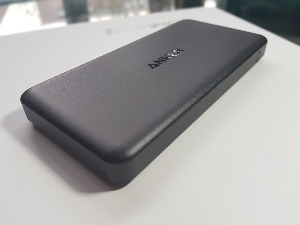
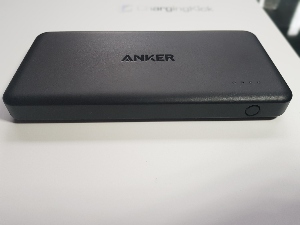
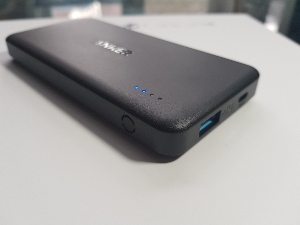
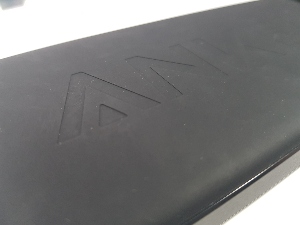
The main material is solid black plastic. It covers the front and edges. What differentiates this model from other Anker power banks is the back of the tested device, which is covered in a black rubber. It has a nice feel, with Anker’s logo along its length. Apart from a great look, it has an important role: it’s great for preventing the unit from slipping out of your hand. The flaw of this feature is its tendency of picking up lint and dust. However, from my personal experience, it isn’t too bad. I’ve collected only a few bits and the rubber is easy to clean.
The corners are slightly curved. On the front and center is Anker’s logo, and in the top right corner are 4 LED lights indicating the power level. On the right edge is a small power button. On the opposite edge is a list of essential information about the power bank.
The most important part is the ports, located on the top edge. One port is a USB-A used to charge external devices, and next to it is a Micro USB port used to charge the power bank.
A USB-to-Micro USB cable and a padded carrying case come with the power bank.
Score
Technology
Ports
The Anker PowerCore II Slim 10000 has a standard USB-A port for output charging and a Micro USB for input charging. It is essentially enough, but USB-C has been slowly becoming the USB standard for input and output charging, and this device doesn’t have it. Despite this flaw, the charging speed is fast due to the Quick Charge 3.0 onboard (as long as the device to be charged supports this feature).
Ports:
Micro USB Input: 5V/2A; 9V/2A
USB-A Output: 5-6V/3A; 6-9V/2A; 9-12V/1.5A
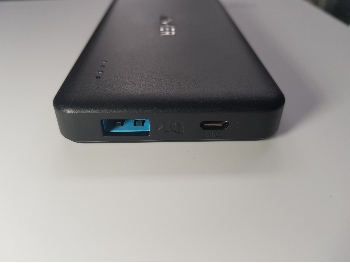
Tech
Anker’s main advantage is its cutting-edge technology. It’s used widely across all its devices and compatible with the products of major smartphone manufacturers.
If your phone has fast-charging technology, this power bank will allow you to charge your phone at the highest speed. What’s more, Quick Charge technology allows you to charge the power bank in 4 hours – a ridiculously short time. However, it requires a Quick Charge charger. Otherwise, the power bank will take 5-10 hours to fully charge, depending on which charger you use.
Charging technologies:
Upgraded PowerIQ 2.0
Quick Charge 3.0
Fast charge for iPhone, Samsung Galaxy
Score
Conclusion
Overall Opinion
This is a solid power bank, one of the best in its price range and battery capacity. I absolutely love the design and build. It has great dimensions, weight, and rubber on the front (why is this not common?!). If you have a fast-charging charger, it can recharge in no time. If future versions add a USB-C port and a slightly faster charging speed, then it will be the best power bank in this range.